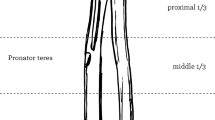Summary
Conservative treated distal radius fractures with extended metaphyseal void and missing cortical support resulted in loss of reduction. From 1988 till 1994 117 fractures of the distal radius were treated by open reduction, filling the metaphyseal void with a cortico-cancellous iliac bone graft and plate fixation. In this retrospective study results after surgical reconstruction were evaluated radiologically and clinically and were discussed to conservative treatment. 30 patients suffering from extraarticular metaphyseal distal radius fracture were evaluated after a mean of 42 months (minimum 20, maximum 68 months) after surgery. Ulnar variance was restored in 70 % to the uninvolved side. Ulnar minus variance up to 2 mm persisted in 30 %. Radial joint angles were restored to normal in 53 %. In 40 % of the patients a loss of reduction up to 10 ° and in 7 % up to 25 ° occured. Active range of motion in the sagittal and frontal plane was equivalent to the non involved side in 30 %. 70 % of the patients showed reduced range of motion up to 20 %. Rotation was unlimited in 77 %, reduced up to 10 % in 23 %. Subjective results were excellent in 90 %, good in 10 %. Compared to conservative therapie, surgery showed superior results.
Zusammenfassung
Bei der konservativen Behandlung distaler Radiusfrakturen kommt es bei ausgedehnter metaphysärer Stauchungszone ohne kortikale Abstützung zum Nachsinken der Fraktur. Von 1988–1994 wurden an unserer Klinik insgesamt 117 (39 metaphysäre und 78 metaphysär-artikuläre) distale Radiusfrakturen offen reponiert, der Defekt mit einem kortikospongiösen Beckenspan aufgefüllt und mittels Plattenosteosynthese fixiert. In einer retrospektiven Studie wurden die Ergebnisse dieser operativen Behandlung nach klinischen und radiologischen Kriterien untersucht; 30 Patienten mit rein metaphysären Radiusfrakturen konnten nach durchschnittlich 42 (Minimum 20, Maximum 68) Monaten nachuntersucht werden. Bei 70 % konnte die Speichenverkürzung gänzlich ausgeglichen werden, bei 30 % bestand eine Niveaudifferenz bis zu 2 mm. Die Gelenkwinkel konnten in 53 % der Fälle seitengleich rekonstruiert werden. Bei 40 % verblieb eine Differenz bis 10 °, bei 7 % bis 25 °. In der sagittalen und frontalen Ebene fanden wir bei 30 % der Patienten ein freies Bewegungsausmaß, bei 70 % eine Einschränkung bis maximal 20 %. Die Rotation war bei 77 % uneingeschränkt, bei 23 % der Patienten bis zu 10 % verringert. 90 % der Patienten bezeichneten ihr Ergebnis als sehr gut, 10 % als gut. Im Vergleich zu unseren konservativ behandelten metaphysären Frakturen ergaben sich bei den operativ behandelten bessere radiologische und funktionelle Ergebnisse.
Similar content being viewed by others
Author information
Authors and Affiliations
Rights and permissions
About this article
Cite this article
Zimmermann, R., Gabl, M., Pechlaner, S. et al. Distal, metaphyseal radius fractures. Results after open reduction, internal plate fixation and cortico-cancellous iliac bone grafting. Unfallchirurg 101, 762–768 (1998). https://doi.org/10.1007/s001130050335
Published:
Issue Date:
DOI: https://doi.org/10.1007/s001130050335




